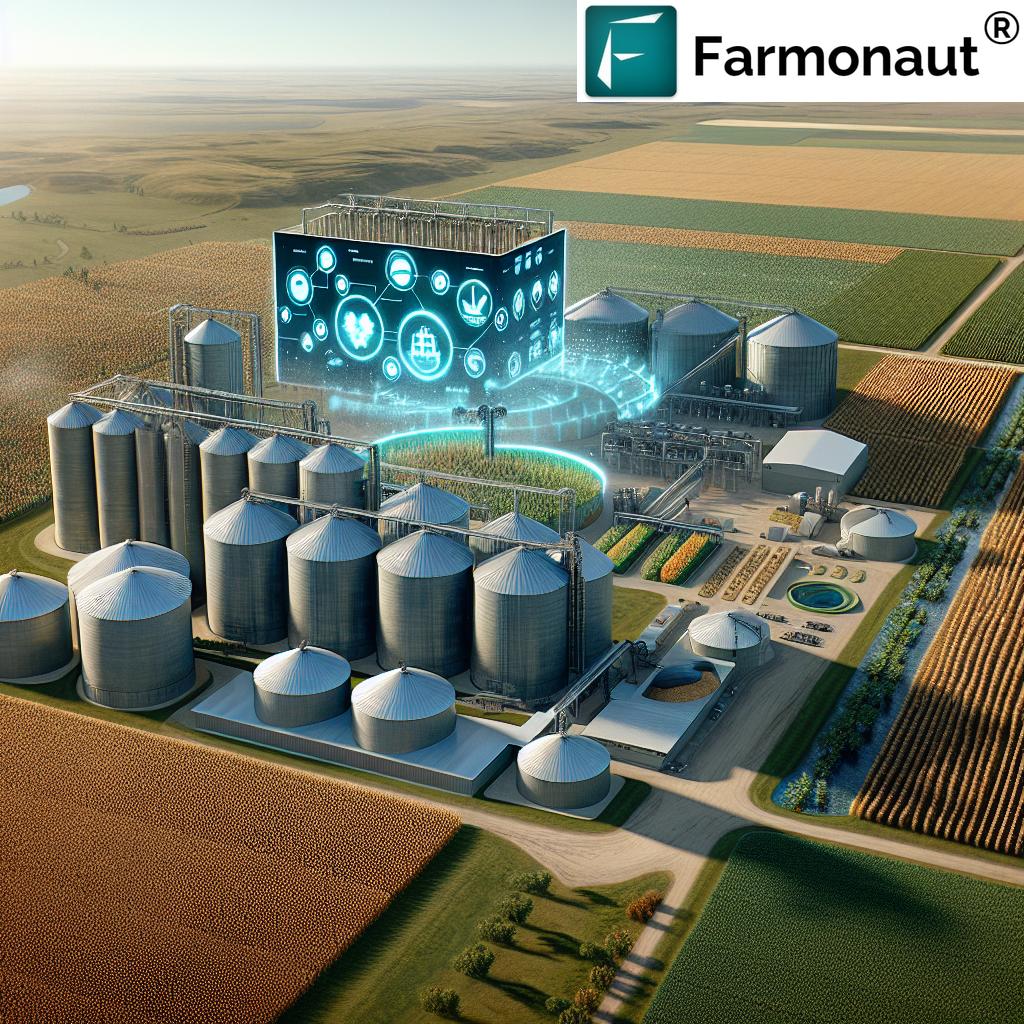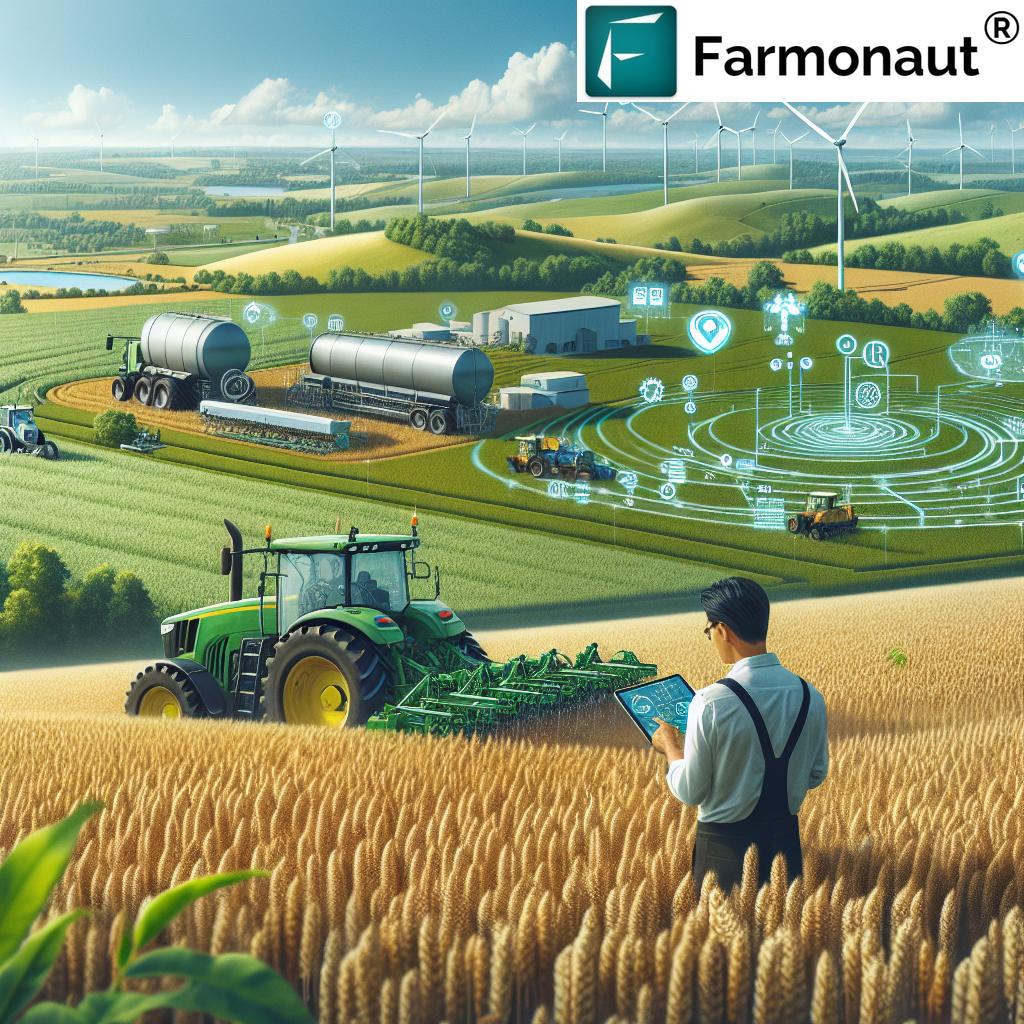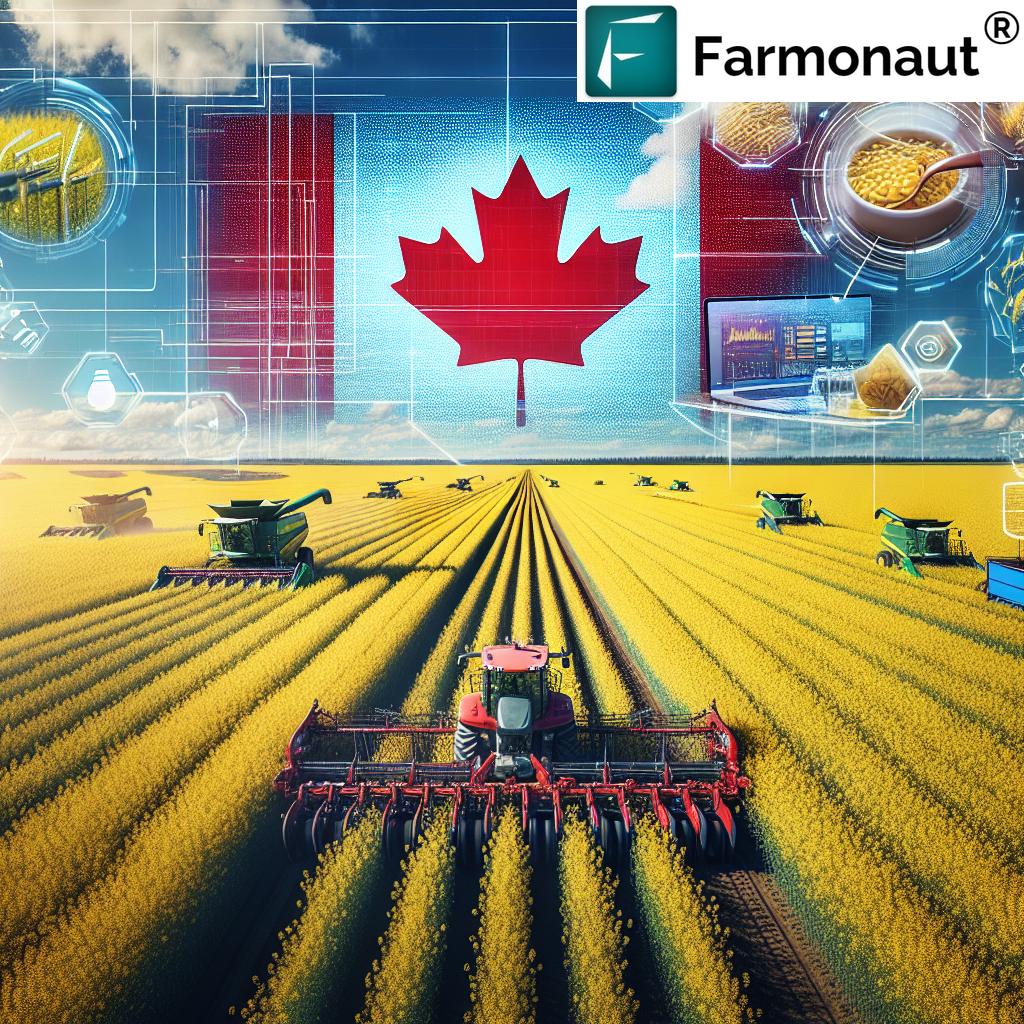Sustainable Canadian Dairy: How Farmonaut’s Technology is Revolutionizing Net-Zero Farming Practices
“Canadian dairy farmers aim to achieve net-zero emissions agriculture by 2050, revolutionizing sustainable farming practices.”
In the ever-evolving landscape of Canadian agriculture, the dairy industry is undergoing a transformative journey towards sustainability. As we delve into the world of sustainable dairy farming in Canada, we’ll explore how innovative agricultural technology and cutting-edge research are reshaping the future of this vital sector. Our focus will be on the remarkable strides being made in regenerative farming practices, soil health improvement, water conservation, and biodiversity enhancement.
At the heart of this revolution is the industry’s ambitious commitment to achieving net-zero emissions agriculture by 2050. This blog post will take you on a comprehensive tour of the cutting-edge techniques and technologies being employed to realize this goal, with a special emphasis on how Farmonaut’s precision agriculture tools are empowering farmers to optimize crop management and resource utilization.
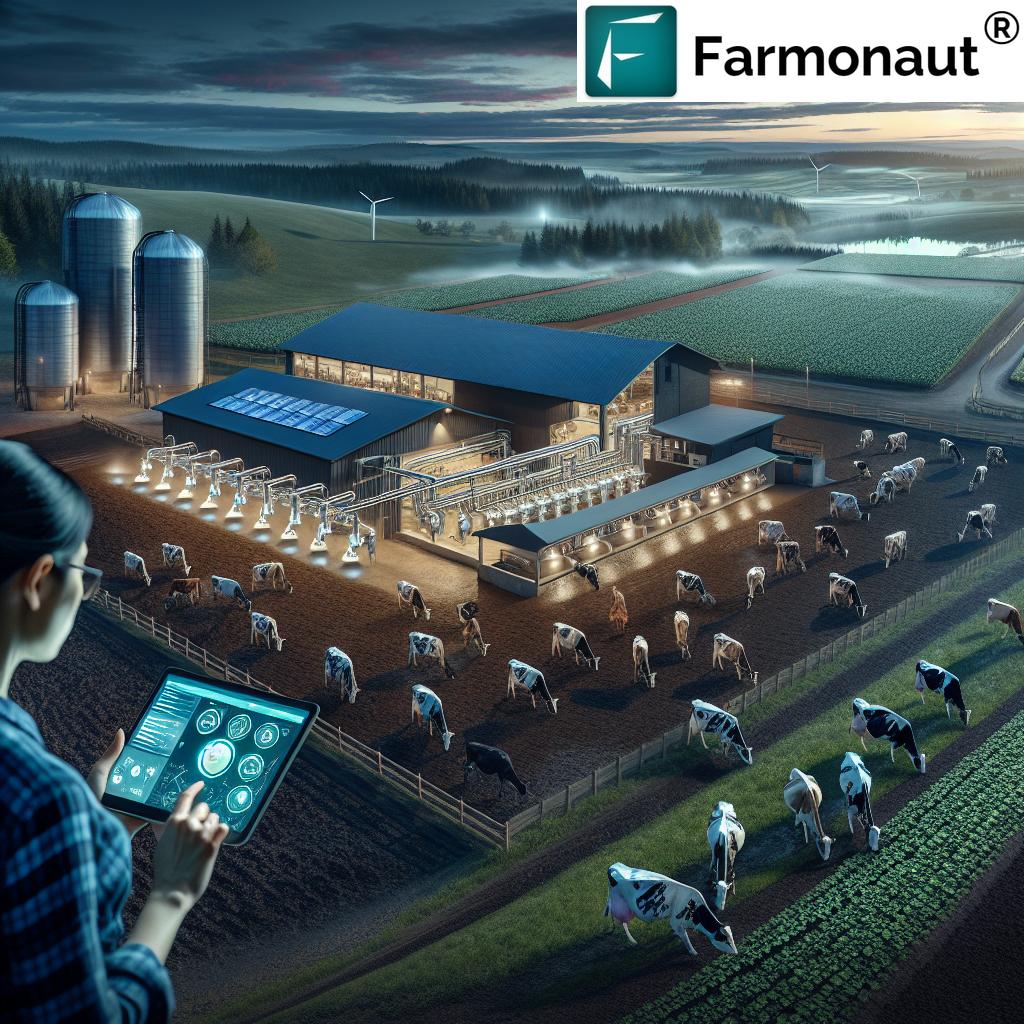
The Canadian Dairy Industry: A Snapshot
Before we dive into the sustainable practices revolutionizing the industry, let’s take a moment to appreciate the significance of the Canadian dairy sector. Spanning across provinces like British Columbia (BC), Alberta (AB), and Ontario (ON), the dairy industry is a cornerstone of Canadian agriculture, contributing significantly to the nation’s economy and food security.
- Diverse product range: From milk to cheese, butter, and yogurt, Canadian dairy farms produce a wide array of high-quality products.
- Economic impact: The dairy sector provides employment and economic stability to rural communities across Canada.
- Nutritional value: Dairy products are a crucial source of essential nutrients for Canadians, supporting overall health and well-being.
As we move forward, it’s crucial to understand how the industry is adapting to meet the challenges of climate change and environmental sustainability while maintaining its commitment to producing safe, nutritious dairy products.
Embracing Regenerative Farming Practices
At the core of sustainable Canadian dairy farming is the adoption of regenerative agriculture practices. These methods go beyond sustainability, actively working to improve the environment and restore ecosystem health. Here’s how Canadian dairy farmers are implementing these practices:
- Soil Health Management: Implementing techniques like no-till farming, cover cropping, and crop rotation to enhance soil structure and fertility.
- Carbon Sequestration: Utilizing practices that capture and store carbon in the soil, reducing greenhouse gas emissions.
- Biodiversity Enhancement: Creating habitats for pollinators and beneficial insects, promoting a balanced ecosystem on the farm.
Farmonaut’s technology plays a crucial role in supporting these regenerative practices. Through satellite-based crop health monitoring, farmers can make informed decisions about soil management and resource allocation, optimizing their regenerative farming efforts.
Water Conservation: A Key Priority
In the face of climate change and increasing water scarcity, Canadian dairy farmers are implementing innovative water conservation strategies:
- Precision Irrigation: Utilizing Farmonaut’s satellite data to optimize irrigation schedules and reduce water waste.
- Rainwater Harvesting: Implementing systems to collect and store rainwater for farm use.
- Water Recycling: Adopting technologies to treat and reuse water from dairy operations.
These efforts not only conserve precious water resources but also contribute to the overall sustainability of dairy farms across Canada.
Enhancing Biodiversity on Dairy Farms
Biodiversity is a critical component of sustainable agriculture. Canadian dairy farmers are taking significant steps to promote and protect biodiversity on their farms:
- Native Plant Cultivation: Planting native species to create diverse ecosystems and support local wildlife.
- Pollinator-Friendly Practices: Establishing pollinator gardens and reducing pesticide use to protect bees and other beneficial insects.
- Wetland Preservation: Maintaining and restoring wetlands on farm properties to support aquatic ecosystems.
Farmonaut’s precision agriculture tools assist farmers in monitoring these biodiversity initiatives, providing data on vegetation health and land use changes over time.
Net-Zero Emissions: The 2050 Goal
The Canadian dairy industry has set an ambitious target of achieving net-zero emissions by 2050. This commitment involves a multi-faceted approach:
- Energy Efficiency: Implementing energy-saving technologies in dairy operations and farm machinery.
- Renewable Energy Adoption: Investing in solar, wind, and biogas energy sources to power farm operations.
- Methane Reduction: Employing advanced feed management and manure handling techniques to minimize methane emissions from cattle.
Farmonaut’s carbon footprinting feature plays a crucial role in this journey, helping farmers track and reduce their environmental impact in real-time.
Explore Farmonaut’s API for advanced agricultural data
Food Safety and Quality Assurance
Sustainability in dairy farming goes hand-in-hand with ensuring the highest standards of food safety and quality. Canadian dairy farmers are at the forefront of implementing rigorous protocols:
- Traceability Systems: Implementing blockchain-based traceability solutions to track dairy products from farm to table.
- Quality Testing: Regular testing of milk and dairy products for nutritional content and safety.
- Animal Welfare Standards: Adhering to strict animal care guidelines to ensure the health and well-being of dairy cows.
Farmonaut’s technology contributes to these efforts by providing real-time data on farm conditions, helping farmers maintain optimal environments for their animals and crops.
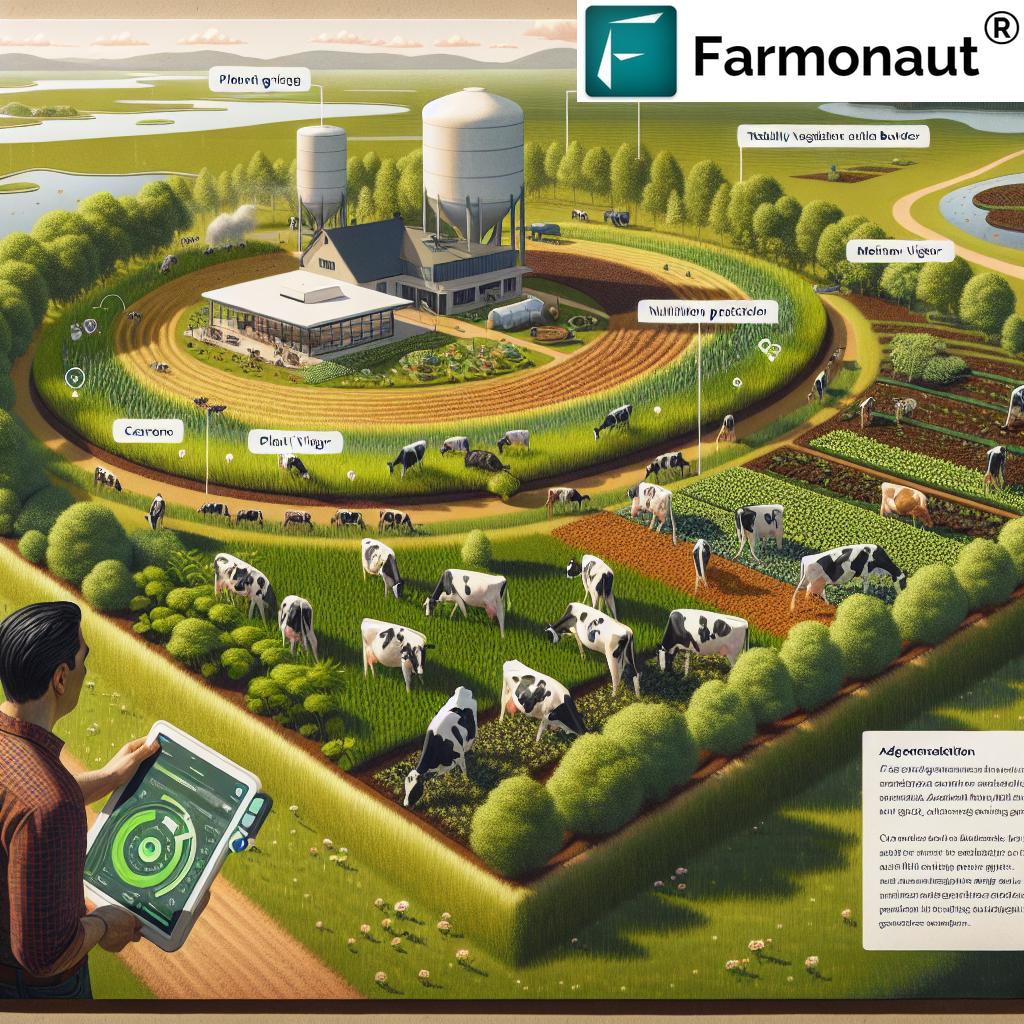
The Role of Precision Agriculture in Sustainable Dairy Farming
“Farmonaut’s precision agriculture tools help optimize crop management across Canadian provinces like BC, AB, and ON.”
Precision agriculture is revolutionizing the way Canadian dairy farmers manage their operations. Farmonaut’s cutting-edge technology is at the forefront of this transformation, offering a suite of tools that empower farmers to make data-driven decisions:
- Satellite-Based Crop Monitoring: Real-time insights into crop health, allowing for timely interventions and optimal resource allocation.
- AI-Powered Advisory System: Personalized recommendations for crop management, pest control, and resource utilization.
- Weather Forecasting: Accurate weather predictions to help farmers plan their activities and protect their crops.
By leveraging these tools, Canadian dairy farmers can significantly improve their productivity while reducing their environmental footprint.
Access Farmonaut’s API Developer Docs for integration options
Sustainable Practices Across Canadian Provinces
The adoption of sustainable dairy farming practices is not limited to a single region but spans across various Canadian provinces. Let’s take a closer look at how different regions are contributing to this sustainable revolution:
- British Columbia (BC): Focus on water conservation and renewable energy adoption in dairy farms.
- Alberta (AB): Implementation of advanced soil health management techniques and carbon sequestration practices.
- Ontario (ON): Leading in precision agriculture adoption and biodiversity enhancement initiatives.
- Quebec (QC): Pioneering in methane reduction strategies and sustainable feed production.
- Saskatchewan (SK): Emphasis on sustainable crop rotation and integrated pest management in dairy farming.
Farmonaut’s technology is adaptable to the unique needs of each region, providing tailored solutions that address specific environmental and agricultural challenges.
Recycling and Waste Management in Dairy Farming
Sustainable dairy farming extends beyond the field to encompass comprehensive waste management and recycling practices:
- Manure Management: Converting dairy waste into biogas for energy production and organic fertilizers.
- Plastic Recycling: Implementing programs to recycle plastic wraps, containers, and other farm plastics.
- Water Recycling: Treating and reusing wastewater from dairy processing for irrigation and cleaning purposes.
These initiatives not only reduce the environmental impact of dairy farming but also create additional value streams for farmers.
Land Management and Conservation
Effective land management is crucial for sustainable dairy farming. Canadian farmers are implementing various strategies to preserve and enhance their land:
- Rotational Grazing: Implementing managed grazing systems to improve pasture health and soil quality.
- Habitat Restoration: Dedicating portions of farmland to restore natural habitats and wildlife corridors.
- Erosion Control: Utilizing cover crops and contour farming to prevent soil erosion and maintain land integrity.
Farmonaut’s satellite imagery and AI-powered analysis help farmers monitor land use changes and make informed decisions about conservation efforts.
The Future of Sustainable Canadian Dairy
As we look towards the future, the Canadian dairy industry is poised for continued innovation and sustainability. Here are some key areas of focus:
- Advanced Genetics: Developing cow breeds that are more efficient in feed conversion and produce less methane.
- Artificial Intelligence in Farm Management: Expanding the use of AI for predictive analysis and automated decision-making in dairy operations.
- Circular Economy Models: Implementing closed-loop systems that minimize waste and maximize resource efficiency.
Farmonaut’s commitment to continuous innovation ensures that Canadian dairy farmers will have access to the latest technologies to support these future endeavors.
Comparative Analysis: Traditional vs. Sustainable Dairy Farming
To better understand the impact of sustainable practices in Canadian dairy farming, let’s compare traditional methods with the sustainable alternatives promoted by Farmonaut’s technology:
| Farming Practice | Traditional Method | Sustainable Alternative | Environmental Impact | Productivity Impact |
|---|---|---|---|---|
| Soil Management | Intensive tilling, chemical fertilizers | No-till farming, cover crops, organic fertilizers | 50% reduction in soil erosion, 30% increase in soil organic matter | 15% increase in crop yield over 5 years |
| Water Conservation | Flood irrigation | Precision irrigation based on Farmonaut’s satellite data | 40% reduction in water usage | 20% improvement in water use efficiency |
| Crop Rotation | Limited rotation | Diverse crop rotation informed by AI analysis | 25% reduction in pest pressure, 20% increase in soil fertility | 10% increase in overall farm productivity |
| Waste Management | Basic manure storage | Biogas production, composting | 60% reduction in methane emissions | New revenue stream from energy production |
| Energy Use | Fossil fuel-dependent | Renewable energy integration (solar, wind) | 70% reduction in carbon footprint | 30% decrease in energy costs |
This table clearly illustrates the significant benefits of adopting sustainable practices in dairy farming, both for the environment and farm productivity. Farmonaut’s technology plays a crucial role in enabling these improvements by providing farmers with the data and insights needed to implement and optimize these sustainable methods.
The Global Impact of Canadian Sustainable Dairy Farming
The sustainable practices adopted by Canadian dairy farmers are not just benefiting the local industry; they’re also contributing to global food security and environmental stewardship. Here’s how:
- Knowledge Sharing: Canadian farmers are sharing their experiences and best practices with the international farming community.
- Technology Export: Innovations like Farmonaut’s precision agriculture tools are being adopted in other countries, spreading sustainable farming practices globally.
- Climate Change Mitigation: By reducing greenhouse gas emissions, Canadian dairy farms are contributing to global climate change mitigation efforts.
As we continue to face global challenges in agriculture and climate change, the Canadian dairy industry stands as a model of innovation and sustainability.
Frequently Asked Questions (FAQ)
- Q: How does Farmonaut’s technology contribute to sustainable dairy farming?
A: Farmonaut provides satellite-based crop monitoring, AI-powered advisory systems, and precision agriculture tools that help farmers optimize resource use, improve crop health, and reduce environmental impact. - Q: What is the goal of net-zero emissions in Canadian dairy farming?
A: The goal is to achieve a balance where the amount of greenhouse gases emitted by dairy farms is equal to or less than the amount removed from the atmosphere by 2050. - Q: How are Canadian dairy farmers improving soil health?
A: Farmers are implementing practices such as no-till farming, cover cropping, and diverse crop rotations to enhance soil structure, fertility, and carbon sequestration. - Q: What role does biodiversity play in sustainable dairy farming?
A: Biodiversity enhances ecosystem resilience, supports natural pest control, and improves overall farm health. Canadian farmers are creating habitats for pollinators and beneficial insects to promote biodiversity. - Q: How is water conservation being addressed in Canadian dairy farms?
A: Farmers are using precision irrigation techniques, rainwater harvesting systems, and water recycling technologies to reduce water usage and improve efficiency.
Conclusion
The journey towards sustainable Canadian dairy farming is well underway, driven by innovative technologies, dedicated farmers, and a commitment to environmental stewardship. As we’ve explored in this blog, the integration of Farmonaut’s precision agriculture tools is playing a pivotal role in revolutionizing net-zero farming practices across Canada.
From soil health management to water conservation, biodiversity enhancement to emissions reduction, Canadian dairy farmers are setting new standards for sustainable agriculture. The industry’s commitment to achieving net-zero emissions by 2050 is not just an ambitious goal; it’s a roadmap for transforming the entire agricultural sector.
As we look to the future, the continued adoption of advanced technologies and sustainable practices will ensure that Canadian dairy remains at the forefront of global agricultural innovation. By embracing these changes, we’re not just preserving the environment; we’re securing a sustainable, productive, and resilient future for generations to come.
Join us in this green revolution. Whether you’re a farmer looking to adopt sustainable practices, a consumer interested in supporting environmentally friendly dairy products, or an innovator with ideas to contribute, there’s a place for you in this exciting journey towards a more sustainable future.





